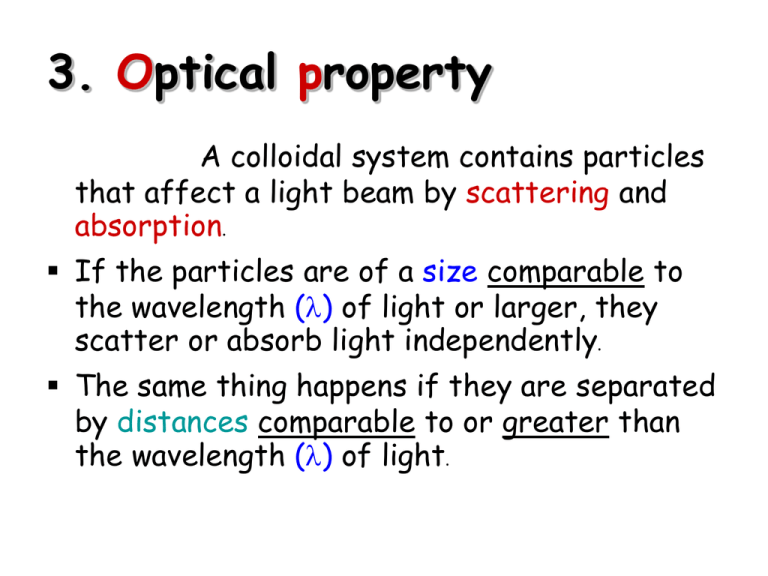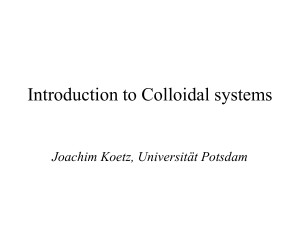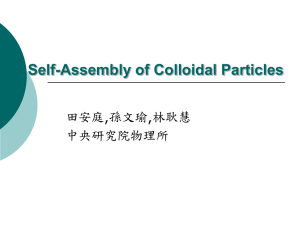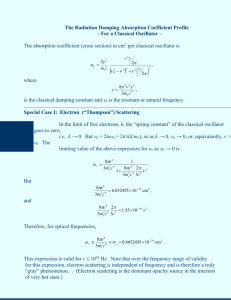3. Optical property
advertisement

3. Optical property A colloidal system contains particles that affect a light beam by scattering and absorption. If the particles are of a size comparable to the wavelength () of light or larger, they scatter or absorb light independently. The same thing happens if they are separated by distances comparable to or greater than the wavelength () of light. 3. Common Optical Phenomena the interaction of light from the sun or moon with the atmosphere, clouds, water, or dust and other particulates Size comparable to the wavelength of light Group Presentation (10 students per group) G3 G4 G5 G6 : : : : Rayleigh Scattering Raman Scattering Mie Scattering Bragg Scattering Turbidity () • a measure of the degree to which the water looses it’s transparency due to the presence of suspended particulates • Measurement of turbidity is a key test of water quality Various parameters influencing the cloudiness of water •Sediments from erosion •Resuspended sediments from the bottom (frequently stir up by bottom feeders like carp) •Waste discharge •Algal growth •Urban runoff Io, is = 84 2 (1+cos2 ); Io 4 r2 iS() Is =turbidity, Io : polarizability of particle For a small particle (Rayleigh scattering) Scattering>>>Absorption Io, is I Absorption : (b=1 cm, C=1M) Beer’s law A = bC A = = - ln I/Io ln(1-x)=-x; x<<<1 Scattering : -ln I/Io = -ln (Io – Is) = -ln (1- Is) = (Is/Io) Io Io Turbidity = = Is/Io = -ln I/Io Experimentally Kc ( 1 cos 2 ) 2 = Is = 2 2 r sin d Io o r (1/M 2Bc) = 16 Kc 3(1 / M 2Bc) Where K = 22[ndn/dc)]2; n = refractive index N 4 related to A Experimentally = 16 Kc 3(1 / M 2Bc) Given : H = 16K = 323(n2(dn/dc)2 3 3NA4 Hc = 1 + 2Bc M Hc Intercept = 1/M c (g cm-3) 3.Colloidal Stability and Its Applications Stabilization serves to prevent colloids from aggregating. Interaction Between Colloid Particles Excluded Volume Repulsion: any overlap between hard particles. Electrostatic interaction: an electrical charge attract or repel van der Waals forces : two dipoles interaction which are either permanent, induced or temporary dipole induces a dipole Entropic forces : according to the second law of thermodynamics, resuling in effective forces even between hard spheres. Steric forces : interparticle forces between polymer-covered surfaces or in solutions containing non-adsorbing polymer, producing an additional repulsive steric stabilization force or attractive depletion force between them. Two main mechanisms for colloid stabilization Steric stabilization interparticle forces between polymer-covered surfaces or in solutions containing non-adsorbing polymer Electrostatic stabilization the mutual repulsion of like electrical charges. Different phases generally have different charge affinities, so that a charge double-layer forms at any interface. Small particle sizes lead to enormous surface areas, and this effect is greatly amplified in colloids. Colloidal Stabilization • Self stabilization • Stabilization by other substances H H+ H+ H+ Adding emulsifying agent + Fe(OH)3 H+ H+ H+ H+ Adsorption on charged surface (electrical double layer) The electrical double layer the variation of electric potential near a surface, and has a large bearing on the behaviour of colloids and other surfaces in contact with solutions Stern Model Helmholtz Capacitor Model Zeta potential, Stern layer Diffuse layer the electrostatic potential generated by the accumulation of ions at the surface of a (colloidal) particle that is organized into an electrical doublelayer, consisting of the Stern layer and the diffuse layer. provide information about the charge on the surface Variation of potential with particle separation Assignmemt-5 (10 students per group) Group Presentation G7 : zeta potential G8 : application of the zeta potential (5 min per group)











